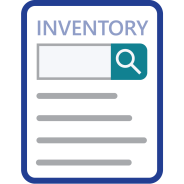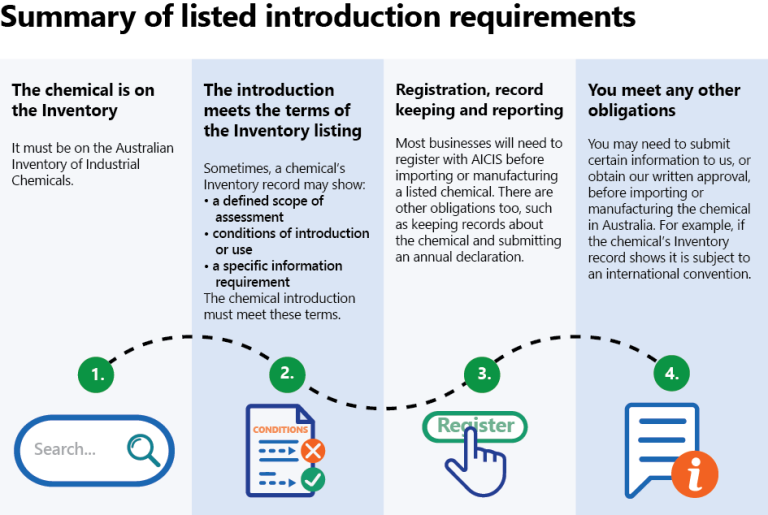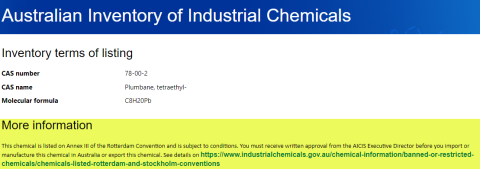Choose from 5 options:
Step 0: Introductions that are in the listed category
- If you are selling soap, read our soaps guide to learn more.
What is a listed introduction?
A chemical importation or manufacture (introduction) is in the listed category if it is both of the following:
- The chemical is on the Australian Inventory of Industrial Chemicals (Inventory).
- The AICIS-registered person or business (introducer) can import or manufacture the chemical within the terms of Inventory listing described in the chemical’s Inventory record.
Who has the chemical identity information?
To search the Inventory, either you or another person or business (for example, your overseas supplier or manufacturer), must know at least one of the following about your chemical’s identity:
- CAS number (recommended)
- CAS name, or AICIS-Approved Chemical Name (AACN) if AICIS has assessed the chemical.
Since the Inventory is based on CAS names and numbers, searching the Inventory using INCI names, product names or common names isn’t recommended. See more search tips, including how you might find CAS numbers or names.
Choose your scenario to learn what to do next.
Scenario 1: Introducer knows the chemical’s CAS number, CAS name or AACN.
Introducer can complete the questionnaire - go to Q1.
Scenario 2: Introducer does not know the CAS number, CAS name or AACN – this is proprietary information and cannot be given to the introducer.
Ask your chemical identity holder to help categorise your chemical introduction. Provide a link to this page and ask them to work through the questionnaire on your behalf.
Ideally, the chemical identity holder should give you the answer to each question, but if this is not possible, then ask for a summary that confirms:
- whether the chemical is on the Inventory
- if the chemical is on the Inventory, whether the listing contains:
- a defined scope of assessment
- conditions of introduction of use
- a specific information requirement
- an obligation relating to the Rotterdam Convention or Minamata Convention on Mercury and requiring approval.
You must help the introducer to categorise their introduction. Complete the questionnaire and either give the introducer the answer to each question (preferred), or provide the introducer with a summary that confirms:
- whether the chemical is on the Inventory
- if the chemical is on the Inventory, whether the listing contains:
- a defined scope of assessment
- conditions of introduction of use
- a specific information requirement
- an obligation relating to the Rotterdam Convention or Minamata Convention on Mercury and requiring approval.
Scenario 3: The person or business who knows the chemical identity information has told you that the chemical does not have an assigned CAS number or CAS name.
This means the chemical is unlikely to be on the Inventory and probably won’t be categorised as a listed introduction.
If this applies, continue with the categorisation process by going directly to Step 1: Introductions that cannot be exempted or reported.
Questionnaire to work out if an introduction is in the listed category
1. Is the chemical on the Inventory?
Search the Inventory
See search tips below.
If the answer is yes, go to question 2.
If the answer is no, your introduction is not eligible for the listed category. Continue with this guide to work out if your introduction is in the exempted, reported or assessed category – go directly to Step 1: Introductions that cannot be exempted or reported.
2. Does the chemical record show any of these?
- Defined scope of assessment
- Conditions of introduction or use
- Specific information requirement
- More information relating to Rotterdam Convention or Minamata Convention on Mercury
A defined scope of assessment describes the parameters of any previous assessment of a chemical, such as how the chemical is used, the introduction volume or quantity, and its concentration in products.
If there is a ‘defined scope of assessment’, it will display under the heading ‘Inventory terms of listing’. See this example:
Conditions of introduction or use are restrictions we've imposed on the importation or manufacture of a chemical. For example, how much (volume) you can import or manufacture (introduce) and where the chemical is permitted to be introduced or used. If there is a condition, it will be listed under the heading ‘Inventory terms of listing’. See this example:
Chemicals subject to the Rotterdam Convention or Minamata Convention on Mercury. If your chemical is subject to one of these conventions, it will be stated under ‘More information’. See this example:
A specific information requirement is an obligation for introducers (or someone on the introducers’ behalf) to provide information about a chemical introduction under certain situations. An example is below:
Select a, b, or c:
a. No, it has none of these.
b. Yes, it contains a defined scope of assessment, or conditions of introduction or use or obligations under a Convention.
c. Yes, but it ONLY has a specific information requirement.
If you answered a, the chemical introduction is in the ‘listed’ category. That is, the importation or manufacture of the chemical is categorised as a listed introduction. Next: Your obligations after categorisation for listed introductions.
If you answered b, go to question 3.
If you answered c, go to question 9.
3. Does the chemical record indicate that prior authorisation is required before introducing or exporting, because the chemical is either subject to the Rotterdam Convention or the Minamata Convention on mercury?
If the answer is no, go to question 4.
If the answer is yes, and there are no other terms of listing (‘conditions of introduction or use’, ‘defined scope of assessment’ or ‘specific information requirements’), then the introduction is in the listed category. But you need to apply for authorisation to introduce or export your chemical:
- Rotterdam Convention: Apply for authorisation to import or export
- Minamata Convention on Mercury: Apply for authorisation to import or export
If you receive authorisation, you must comply with AICIS obligations for listed introductions (if applicable) as well as any others that apply under the Convention.
If the answer is yes, and there is at least one other term of listing (‘conditions of introduction or use’, ‘defined scope of assessment’ or ‘specific information requirements’), contact us using our online form and select the topic ‘Categorising chemical introductions’.
4. Does the chemical record show any ‘conditions of introduction or use’?
If the answer is yes, go to question 5.
If the answer is no, go to question 6.
5. Will the chemical be introduced within the boundaries of the conditions of introduction or use?
Read the conditions of introduction or use on the chemical’s Inventory record and compare this with the way you’re importing/manufacturing and using the chemical.
Conditions of introduction or use are restrictions we've imposed on the importation or manufacture of a chemical. The conditions are included to manage risks to human health or the environment (if required). For example, conditions on the maximum quantity or volume of chemical that can be imported or manufactured and where the chemical is permitted to be used.
Example
Conditions of introduction or use: the chemical can only be used at a specific site ‘A’.
You plan to use the chemical at other sites.
Outcome: your introduction does not meet the condition. Your answer to this question is ‘no’.
If the answer is yes, go to question 6.
If the answer is no, and there are no other terms of listing (‘defined scope of assessment’ or ‘specific information requirements’), then you must not manufacture or import a chemical in circumstances outside of the conditions. You can apply to vary the conditions of introduction or use. If we approve it, your introduction can be in the listed category. Next: Apply to vary the Inventory terms of listing (fee applies).
If the answer is no and there are other terms of listing (‘defined scope of assessment’ or ‘specific information requirements’), contact us using our online form and select the topic ‘Categorising chemical introductions’.
6. Does the chemical record show a ‘defined scope of assessment’?
If the answer is yes, go to question 7.
If the answer is no, go to question 8.
7. Is the introduction within the parameters of the defined scope of assessment?
If the answer is yes, go to question 8.
If the answer is no, you have 3 options:
Option 1: Continue with this guide to work out if your introduction can be in the exempted or reported category. If categorised as exempted or reported, you must comply with all associated regulatory obligations. Go to Step 1: Introductions that cannot be exempted or reported.
Option 2: You can apply to change the parameters of the defined scope of assessment for a chemical's listing to match your proposed introduction circumstances. If we approve it, your introduction can be in the listed category. Next: Apply to vary the Inventory terms of listing (fee applies). Note – if the chemical record also shows a ‘specific information requirement’, contact us using our online form and select the topic ‘Categorising chemical introductions’.
Option 3: If the chemical is being introduced to test its commercial potential in Australia, the introducer can apply for a commercial evaluation authorisation – fee, time limit and strict eligibility criteria apply.
8. Does the chemical record show a ‘specific information requirement’?
If the answer is yes, go to question 9.
If the answer is no, the chemical introduction is in the ‘listed’ category. That is, the importation or manufacture of the chemical is categorised as a listed introduction.
Next: ‘Your obligations after categorisation for listed introductions’.
9. Do you need to submit information to AICIS under the ‘specific information requirement’?
To answer this question, you need to use our guidance to work out if you need to submit information based on your chemical’s use and other aspects of your introduction.
A specific information requirement does not automatically mean you need to submit the specific information requirement (SIR) form.
If the answer is no, because you determined that the chemical introduction is within the terms of listing, then you do not need to provide information about your chemical introduction. The importation or manufacture of your chemical is categorised as a listed introduction.
Next: ‘Your obligations after categorisation for listed introductions’.
If the answer is yes after working through our guide, you must submit an SIR form in AICIS Business Services) within the specified timeframe.
Before you submit, we recommend reading our guidance to help you correctly complete the SIR form that applies to your circumstance. Our guides include tips and a preview of the questions in the form.
By doing this, you have determined that your chemical introduction will be in accordance with the terms of listing. Therefore, the importation or manufacture of your chemical is categorised as a listed introduction.
Next: ‘Your obligations after categorisation for listed introductions’.
Tips on how to search the Inventory
The Australian Inventory of Industrial Chemicals (Inventory) is an online database of industrial chemicals that are being manufactured or imported into Australia.
If you have a mixture or product that contains more than one chemical, you must search for each one separately.
Search the Inventory using the chemical's CAS number. If you don't know the CAS number or the chemical does not have an assigned CAS number, search the Inventory using the chemical's CAS name (using the keyword search).
Ask your chemical's supplier or manufacturer if they can provide the CAS number. Otherwise ask for the chemical's CAS name. You may also want to try CAS Common Chemistry.
No search results or too many results
Did you search using the chemical's CAS number or CAS name?
If no, then we recommend that you search using the chemical's CAS number (preferred), or CAS name. This is because a term of Inventory listing is the CAS name and CAS number for a chemical.
If yes, then check if it is one of these reasons:
- The chemical meets our legal definition of a naturally occurring chemical - chemicals that meet this definition do not need to be on the Inventory.
- It’s a mixture (such as an alloy or hydrate) – the Inventory only contains names of chemicals, not mixtures.
- You entered an incorrect CAS number or it doesn’t match the CAS number format. For example you may have added a space between the numbers or hyphens.
- You entered an outdated CAS number. Sometimes CAS replaces a chemical’s CAS number with a new one, so you need to make sure that you’re using the updated CAS number. You can check if you have an up-to-date CAS number for your chemical by searching chemical databases such as ChemIDPlus and SciFinder-n.
Still no result after searching the chemical's CAS number?
You can ask us to check if your chemical is confidentially listed on the Inventory. This is because there are some chemicals that are listed on the Inventory where the CAS name and CAS number are protected as confidential business information (CBI). If it is not confidentially listed on the Inventory, then you must proceed to Step 1 of the Categorisation Guide to work out your chemical introduction category.
Trade names, product names and INCI names
The Inventory is a database of chemicals, not products, mixtures or formulations. Therefore it does not contain product names, trade or marketing names and rarely contains INCI or common chemical names. We recommend finding a CAS number or CAS name for each chemical that you want to search. For example:
Search using the CAS number or name |
Don’t search using trade or common names |
| 107-21-1 / 1,2-Ethanediol 57-55-6 / 1,2-Propanediol | Antifreeze |
| 144-55-8 / Carbonic acid, monosodium salt | Baking soda |
| 77-92-9 / 1,2,3-Propanetricarboxylic acid, 2-hydroxy- | Citric acid |
| 9005-25-8 / Starch | Corn starch |
| 7487-88-9 / Sulfuric acid magnesium salt (1:1) | Epsom salt |
| 56-81-5 / 1,2,3-Propanetriol | Glycerine |
| 8000-28-0 / Essential oils, lavender | Lavender oil |
| 13463-67-7 / Titanium oxide (TiO2) | Liquid paper |
| 1310-73-2 / Sodium hydroxide (Na(OH)) | Lye |
| 68917-75-9 / Oils, wintergreen | Wintergreen oil |
Important: These CAS numbers are examples only. It is the introducer’s responsibility to correctly identify and know the chemistry of their introductions.











